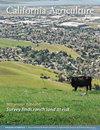索尔顿海:介绍一个不断发展的系统和科学的作用
IF 1.1
4区 农林科学
Q2 AGRICULTURE, MULTIDISCIPLINARY
引用次数: 0
摘要
虽然在20世纪的大部分时间里,索尔顿海是一个相对稳定的生态系统,但最近从农业到城市的水资源转移对该地区的生态造成了重大影响,包括预计所有鱼类和依赖鱼类的食鱼鸟类都会损失。照片:加利福尼亚DWR。索尔顿海位于南加州,是一个咸水终端湖,在过去一个世纪左右的时间里,它有着许多特征。自1905年科罗拉多河下游洪水部分淹没索尔顿水槽而重新出现以来,它一直是加州表面积最大的湖,占地约350平方英里(水教育基金会,2001年)。在20世纪下半叶,它被称为世界上产量最高的渔业之一,在20世纪60年代每年吸引150多万游客,比当时参观约塞米蒂国家公园的游客还多,其中大多数是为了捕鱼(Cohn 2000;Harris等人1969)。在整个20世纪,该海域拥有400多种候鸟和留鸟的栖息地,是太平洋航线上的一个重要中转站,即使不是全世界,也是美国最重要的观鸟地点之一(CNRA 2006;Cowan 2014;Schwabe等人2008)。然而,其近90%的流入量包括帝国灌溉区(IID)约50万英亩灌溉农田的农业排水,以及暴露在极端干旱的气候中导致过度蒸发(每年约130万英亩英尺),随着湖泊污染加剧,盐度几乎是海洋的两倍,海洋的自然吸引力已经消退(Fogel和Schwabe 2021;Lyons和Hung 2021)。这样的结果并不意外,因为尽管海洋在过去发挥了许多作用,但从管理和水权的角度来看,它最著名的作用(如果不是主要作用的话)是作为“灌溉排水水库”(Littleworth和Garner,2017,第256页)。随着2002年量化解决协议(QSA)的通过,地方-州-联邦本文章由计算机程序翻译,如有差异,请以英文原文为准。
The Salton Sea: An introduction to an evolving system and the role of science
While the Salton Sea was a relatively stable ecosystem for most of the 20th century, recent agricultural-to-urban water transfers have caused significant impacts on the region's ecology, including the expected loss of all fish and the fish-eating birds that are reliant on them. Photo: California DWR. The Salton Sea, located in Southern California, is a saline terminal lake that has had many identities over the past century or so. Since its reincarnation in 1905 due to lower Colorado River flooding that partially refilled the Salton Sink, it has been California’s largest lake by surface area, covering approximately 350 square miles (Water Education Foundation 2001). In the second half of the 20th century, it was referred to as one of the most productive fisheries in the world, drawing more than 1.5 million annual visitors in the 1960s — more than visited Yosemite National Park at the time — the majority of whom were there for fishing (Cohn 2000; Harris et al. 1969). Throughout the 20th century, with a habitat that supported over 400 species of migratory and resident birds and served as an important stopover along the Pacific Flyway, the Sea warranted recognition as one of the premier bird watching locations in the United States, if not the world (CNRA 2006; Cowan 2014; Schwabe et al. 2008). Yet with nearly 90% of its inflow comprised of agricultural drainage waters from the approximately 500,000 acres of irrigated farmland in the Imperial Irrigation District (IID), and exposure to an extremely arid climate that results in excessive evaporation (~ 1.3 million acre-feet annually), the Sea’s natural attractions have faded as the lake has become more polluted and nearly twice as saline as the ocean (Fogel and Schwabe 2021; Lyons and Hung 2021). Such an outcome was not unexpected given that while the Sea has played many roles in the past, its most well-known if not primary role from a management and water rights perspective has been as a “reservoir for irrigation drainage” (Littleworth and Garner 2017, p. 256). With the passage of the 2002 Quantification Settlement Agreement (QSA) — a local-state-federal
求助全文
通过发布文献求助,成功后即可免费获取论文全文。
去求助
来源期刊

California Agriculture
农林科学-农业综合
CiteScore
2.40
自引率
7.70%
发文量
17
审稿时长
>12 weeks
期刊介绍:
Information not localized
 求助内容:
求助内容: 应助结果提醒方式:
应助结果提醒方式:


